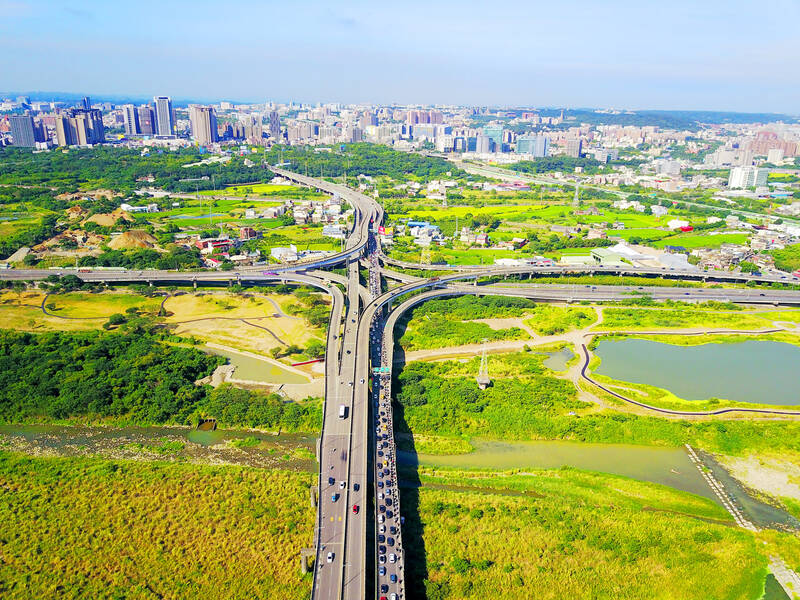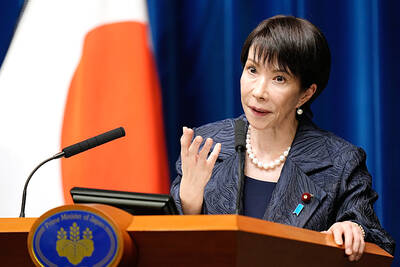Jhubei City in Hsinchu County recorded the nation’s highest growth in absolute population over the past five years, while the highest rate of growth by percentage occurred in Lienchiang County’s Beigan Township (北竿), according to statistics released last week by the Ministry of the Interior.
Jhubei, near the Hsinchu Science Park, saw its population expand by 19,085 people from 2018 through the third quarter of last year. New Taipei City’s Linkou (林口) and Tamsui (淡水) districts were in second and third place, the data showed.
The statistics cover 20 localities that had the largest population increases, including county-administered cities, districts and townships.

Photo courtesy of the Hsinchu County Government
The populations of New Taipei City’s Linkou and Tamsui districts increased by 17,160 and 15,901 respectively. Taichung’s Beitun District (北屯) registered 14,565 new residents.
Several districts in Taoyuan were next-highest in their increases. Taoyuan (桃園) and Jhongli (中壢) districts saw their populations increase by 12,234 and 10,449 respectively, while Gueishan (龜山) went up by 8,651 people, and Bade (八德) 7,882.
Rounding out the top 10 are New Taipei City’s Sijhih District (汐止) with 7,347 new residents, and Kaohsiung’s Renwu District (仁武) with 7,106.
From the remainder of the localities, all but one — Hsinchu County’s Hukou Township (湖口), north of Jhubei — are in Taiwan’s six special municipalities, where nearly 70 percent of Taiwan’s population resides.
City officials in New Taipei City and Taoyuan cited lower housing prices, good public transportation, and access to jobs and recreation as factors driving population growth, particularly among younger people.
Jhubei Mayor Cheng Chao-fang (鄭朝方) said that Hsinchu city and county form a common metropolitan area, whose several science and technology parks have attracted major companies offering large numbers of well-paying jobs.
The ministry also published statistics on the rate of population growth, showing that Lienchiang’s Beigan Township, with a population of about 3,000, grew the most in terms of percentage per quarter.
Beigan Township recorded an average population increase of 1.53 percent per quarter over the five-year period.
Rounding out the top five were Linkou at 0.85 percent per quarter, Taoyuan’s Fusing District (復興) at 0.63 percent, Hualien’s Fengbin Township (豐濱) with 0.6 percent and Jhubei with 0.58 percent.
Locations with the largest rate of population decline were all in Taipei. The capital city’s Xinyi (信義), Songshan (松山), Zhongshan (中山), Daan (大安) and Wanhua (萬華) districts all registered decreases of more than 0.5 percent per quarter during the five-year period, the data showed.
Taipei’s population loss was one of the main topics of debate in November’s Taipei mayoral election, with candidates discussing high housing prices and low wages as factors driving young families away from the capital.
Former Taipei deputy mayor Vivian Huang (黃珊珊) said that Taipei’s population decline should be understood in the context of a nationwide population decline since 2020.
All of Taiwan’s six special municipalities, except for Taoyuan, have registered population declines, and many Taipei residents have chosen to move to New Taipei City or Taoyuan because of their convenient transportation links to Taipei, Huang said during the recent election campaign.
Hualien Civil Affairs Department Deputy Director Lee Wei (李葳) downplayed Fengbin Township’s population growth rate, saying that the rural township has only 4,300 residents and the increase is “no big deal.”
“The denominator is low, so if a few people move in, the growth rate is very large,” Lee said.

The Ministry of Foreign Affairs (MOFA) yesterday voiced dissatisfaction with the Comprehensive and Progressive Agreement for Trans- Pacific Partnership (CPTPP), whose latest meeting, concluded earlier the same day, appeared not to address the country’s application. In a statement, MOFA said the CPTPP commission had "once again failed to fairly process Taiwan’s application," attributing the inaction to the bloc’s "succumbing to political pressure," without elaborating. Taiwan submitted its CPTPP application under the name "Separate Customs Territory of Taiwan, Penghu, Kinmen and Matsu" on Sept. 22, 2021 -- less than a week after China

THE GOOD WORD: More than 100 colleges on both sides of the Pacific will work together to bring students to Taiwan so they can learn Mandarin where it is spoken A total of 102 universities from Taiwan and the US are collaborating in a push to promote Taiwan as the first-choice place to learn Mandarin, with seven Mandarin learning centers stood up in the US to train and support teachers, the Foundation for International Cooperation in Higher Education of Taiwan (FICHET) said. At the annual convention of the American Council on the Teaching of Foreign Languages held over the weekend in New Orleans, Louisiana, a Taiwan Pavilion was jointly run by 17 representative teams from the FICHET, the Overseas Community Affairs Council, the Steering Committee for the Test of Proficiency-Huayu, the

A home-style restaurant opened by a Taiwanese woman in Quezon City in Metro Manila has been featured in the first-ever Michelin Guide honoring exceptional restaurants in the Philippines. The restaurant, Fong Wei Wu (豐味屋), was one of 74 eateries to receive a “Michelin Selected” honor in the guide, while one restaurant received two Michelin stars, eight received one star and 25 were awarded a “Bib Gourmand.” The guide, which was limited to restaurants in Metro Manila and Cebu, was published on Oct. 30. In an interview, Feng Wei Wu’s owner and chef, Linda, said that as a restaurateur in her 60s, receiving an

MORE RETALIATION: China would adopt a long-term pressure strategy to prevent other countries or future prime ministers following in Sanae Takaichi’s steps, an academic said Taiwan should maintain communications with Japan, as Japanese Prime Minister Sanae Takaichi is to lead a revision of security documents, Taiwanese academics said yesterday. Tensions have risen between Japan and China over remarks by Takaichi earlier this month that the use of force against Taiwan would constitute a “survival-threatening situation” for Japan. Prospect Foundation president Lai I-chung (賴怡忠) yesterday said Takaichi’s stance regarding Taiwan is the same as past Japanese prime ministers, but her position is clearer than that of her predecessors Fumio Kishida and Shigeru Ishiba. Although Japan views a “Taiwan contingency” as a “survival-threatening situation,” which would allow its military to